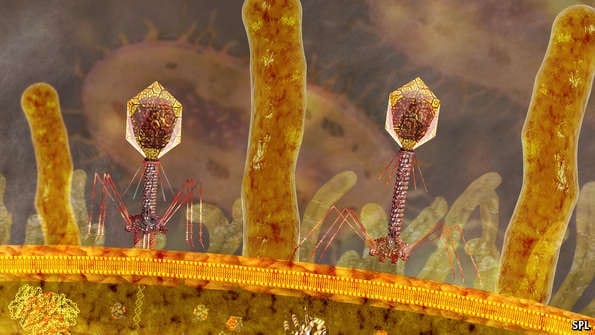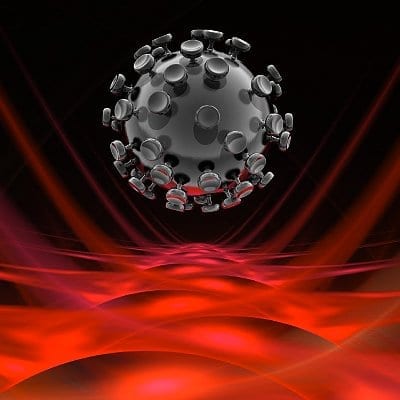
Synthetic biology: Strange medicine
SET a thief to catch a thief is an old proverb. In the 1920s, shortly after the discovery of viruses, it was put to good use by doctors. They found they could treat certain infections with bacteriophages—viruses that attack bacterial cells but not mammalian ones.
Phage therapy, as this practice is known, fell out of favour in the West after the development of antibiotics, although it continued in parts of the old Soviet sphere of influence. (These days, research is still carried out in Georgia and Poland). But antibiotics are faltering as resistant strains of germ evolve. Some Western researchers are therefore looking afresh at phages, hoping, with modern methods, to turn them into tailored treatments for infection.
One such group of scientists works at Synthetic Genomics in La Jolla, California. This firm, the creation of Craig Venter, an entrepreneurial geneticist who once took on the American and British research establishments in a race to sequence the human genome, plans to re-engineer several sorts of organism—phages included—into what it hopes will be useful products.
The phage work is run by Sammy Farah, head of the firm’s vaccines and therapeutics unit. His team is developing phages for use against antibiotic-resistant strains of Pseudomonas, a bug that causes skin infections, sepsis and—particularly in those with cystic fibrosis—potentially fatal pneumonia. Phage therapies in Georgia and Poland mix dozens of strains of wild phage together into a cocktail, in the hope that one will do the trick against the bug that a patient is infected with. Dr Farah and his colleagues, by contrast, are able to synthesise viruses from scratch, using off-the-shelf chemicals. They can thus design them precisely, down to the last atom.
The plan is to come up with one or two super-phages that will hit multiple strains of Pseudomonas. In effect, these phages will be giant self-replicating drug molecules that automatically calibrate the size of their dose—for, when all of the target bacteria have been killed, they can no longer breed. The benefit, from the patient’s point of view, is help for an infection that is currently untreatable except, perhaps, by getting on a plane to Warsaw or Tbilisi. From the firm’s point of view, an equally important benefit is that synthetic viruses can be patented. Wild ones cannot.
Read more: A way to treat bacterial infections with artificial viruses
The Latest on: Artificial viruses
[google_news title=”” keyword=”Artificial viruses” num_posts=”10″ blurb_length=”0″ show_thumb=”left”]
via Google News
The Latest on: Artificial viruses
- What Did Union Nurses Rally Against This Week?on April 27, 2024 at 9:05 pm
During a protest outside the Kaiser Permanente San Francisco Medical Center this week, union nurses rallied against: True or False: A new study based on empirical measurements showed that olfactory ...
- 10 of the Best Sci-Fi Movies to Stream on Max Right Nowon April 27, 2024 at 1:00 pm
Kourtnee covers TV streaming services and home entertainment news and reviews at CNET. She previously worked as an entertainment reporter at Showbiz Cheat Sheet where she wrote about film, television, ...
- Survey: More US workers now fear losing jobs, lower wages due to AIon April 27, 2024 at 10:33 am
More U.S. workers fear losing their jobs due to artificial intelligence compared to last year, according to two new studies.
- Avian flu has spread to cows, milk — and experts worry human outbreak could be nexton April 26, 2024 at 9:09 pm
So far, culling infected flocks hasn't been enough to curtail the virus, identified Wednesday in another Michigan commercial poultry facility.
- Blood test powered by AI could catch osteoarthritis 8 years earlier than X-ray, early data showon April 26, 2024 at 11:00 am
A new blood test could determine whether someone will develop knee osteoarthritis up to eight years before structural damage is picked up by an X-ray.
- Four decades in, the Pet Shop Boys know the secret to staying coolon April 25, 2024 at 10:58 pm
Forty years and 50 million record sales after the Pet Shop Boys rose to fame with “West End Girls,” the iconic British duo is releasing a new album ...
- Moderna Employees Should Use ChatGPT at Least 20 Times a Day, CEO Sayson April 25, 2024 at 1:45 pm
Moderna and OpenAI announced an ongoing partnership Wednesday to embed AI across Moderna’s business, giving its teams — including legal, research, and manufacturing — access to ChatGPT Enterprise. The ...
- Calls for Strategic Collaborations to Tackle AI Security Threatson April 25, 2024 at 6:51 am
AI’s introduction into cyber-threat scenery made it unbelievably faster for hackers. Analytical reports predict turnover will skyrocket to $10.5 quadrillion by 2025 as AI systems become more powerful ...
- Apple’s most useful AI tricks could be keeping your Mac more secure – here’s howon April 25, 2024 at 5:25 am
But what is unusual is the sheer size of the XProtect update. As Oakley puts it, “developing that many [definitions] by hand would normally take considerable time and effort.” And that raises an ...
- Pentagon watchdog to audit $50M in US grants to Chinese research labs revealed by Sen. Joni Ernston April 24, 2024 at 1:51 pm
The Department of Defense should defend the nation, not support research with the potential to do us harm,” Iowa Republican Sen. Joni Ernst told The Post.
via Bing News










